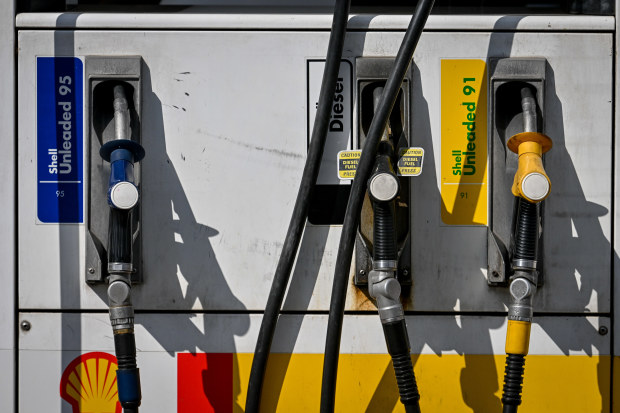How to save $25 on your next tank of petrol
Motorists in Sydney and Melbourne can save up to $25 a tank by filling up ahead of an expected steep increase in prices by Christmas that could potentially be followed by further rises after Iranian-backed Houthi militants stepped up attacks on fuel tankers.
Melbourne’s cheapest fuel on Tuesday was $1.66 a litre, according to PetrolSpy, while its most expensive was $2.16. Sydney had a bottom of $1.65 a litre and a top of $2.20.

Price differences of more than 50¢ a litre can be found between the cheapest and most expensive fuel options in Melbourne and Sydney. Eddie Jim
The average price of fuel in Melbourne on Tuesday was $1.87 a litre, according to analytics group Informed Sources, while in Sydney, it was $2.03.
But Australasian Convenience and Petroleum Marketers Association chief executive Mark McKenzie said prices would increase daily as the two major cities have both entered the upward turn of the petrol cycle. He estimated that citywide averages would hit about $2.10 a litre by Christmas.
This comes as the latest The Australian Financial Review/Freshwater Strategy poll, released on Monday, found cost of living was the single largest concern among voters,
Mr McKenzie said prices changed store by store, rather than by suburb, as individual outlets played a game of “discount leapfrog”.
One service station at Epping in Melbourne’s north had fuel for $1.67 a litre on Tuesday, with another outlet, just 500 metres away, selling for $2.16 a litre.
A Croydon Park outlet, in Sydney’s inner west, was selling for $1.66 a litre, while a rival just 800 metres away was selling for $2.17. Given the average fill-up was about 50 litres, Mr McKenzie said saving 50 cents a litre could mean a total saving of about $25 a tank.
“I would definitely fill up sooner rather than later. And make sure to shop around because there are bargains out there,” he said.
Oil prices climbed and shipping in the Red Sea was grinding to a halt after Iranian-backed Houthi militants stepped up attacks on vessels, raising fears about the impact of the Israel-Hamas war on the global economy.
European natural gas prices surged by as much as 13 per cent amid the most concrete sign yet of disruption to energy flows since the start of the war in Gaza. Brent oil futures jumped as much as 3.9 per cent.
NRMA spokesman Peter Khoury said that while the incident could result in prices increasing by 2¢ to 3¢ a litre in Australia, it would take at least two weeks to feed through to local outlets.
“It’s just a matter of how supply reacts and whether ships have to be re-routed,” he said.
Mr Khoury said independent retailers were more likely to trade on prices from the bottom end of the cycle for as long as possible. But outside the state-based cycles, he added, there was an overall decline in prices following a fall in demand for oil after Organisation of Petroleum Exporting Countries and their allies announced they would cut production by 1.1 million barrels a day until the end of the year.
RACQ fuel expert Dr Ian Jeffreys said he did not expect the decision by some oil shipping companies to avoid the Suez Canal and the Red Sea to have any “major impact” on fuel prices in Australia.
He said that when a container ship ran aground in the Suez Canal in 2021, causing the complete closure of the shipping route, oil prices rose by about $US3 a barrel, which resulted in an increase of 3¢ to 4¢ a litre on the price of fuel in Australia.
“There are a multitude of turbulent factors impacting global oil prices right now and the halt of some shipments through the Suez Canal is a minor one,” Dr Jeffreys said.
The average price for regular unleaded petrol across south-east Queensland, he said, was $1.80 a litre. In Greater Brisbane, 33 per cent of stations were charging below $1.75 per litre for regular unleaded.
“South-east Queensland is entering the cheap phase of its fuel price cycle, and we expect prices to stay relatively cheap over the Christmas and new year period,” Dr Jeffreys said.
“It’s a great time to fill up and take advantage of this cheaper fuel, which is widely available.”
RACV spokeswoman Eleanor Colonico said fuel prices were calculated using a range of factors, including geographical area, availability, international benchmark prices, taxes, the value of the Australian dollar relative to the US dollar, and levels of competition.
The average fuel price in Adelaide on Tuesday was $2.02 a litre, according to Informed Sources, while it was $1.70 in Perth, $1.90 in Canberra, and $1.87 in Hobart and Darwin.
Introducing your Newsfeed
Follow the topics, people and companies that matter to you.
Find out moreRead More
Latest In Transport
Fetching latest articles